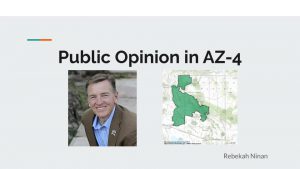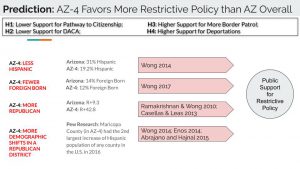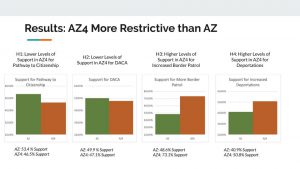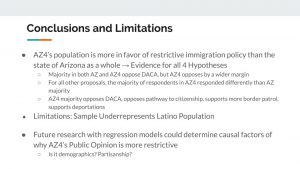
Note: my research plan changed from Assignment 2 to Assignment 3, with Professor Valenzuela’s permission.
Existing research on the relationship between media coverage and immigration attitudes, and by extension support for candidates that support restrictive policies, is extensive. Scholarship suggests higher % immigrant and Latino populations correlates to more accepting policies supported, but that if the Latino population is rising in a Republican district it will provoke a white “backlash” and increase support for Republican candidates with restrictive policies–especially when political rhetoric and/or national media frames increasing immigration as a Latino threat (Wong 2014, Enos 2014, Aptekar 2008, Hopkins 2010m Abrajano & Hajnal 2015, Newman et. al 2018). National media coverage of immigration has been shown to often frame immigration as a Latino threat, with a negative tone (Abrajano & Hajnal 2015). Scholarship has demonstrated that states close to the Southern border are most likely to have media that frames the issue as a Latino threat, or cover immigration with a negative tone, than states farther away (Branton & Dunway 2009).
Since District 8 is Republican-leaning with a growing foreign-born population, the literature would predict that media frames immigration as a Latino threat with a negative tone. However, since Michigan is far from the Southern border, literature doesn’t necessarily concretely predict how salient the issue will be and how frequent coverage is. Furthermore, it does not predict what kind of threat the Latino immigration is framed as. Finally, existing literature has not explored how county-level coverage might differ in a segregated, politically polarized district.
Michigan’s District 8 is far from the Southern border and political polarized, with overall demographics are 8.4% foreign born–but the district is highly segregated. In 2017, Livingston county was 97% white; Oakland was 75% white, and Ingham county was 75% (but the city within it, Lansing, was 55% white with an increasing foreign born population around 13%). From this emerges two research questions:
- What is the focus, framing, and tone of local media coverage in District 8 from December 11 2018 to January 31 2019 on immigration and the government shutdown?
- Are there significant differences in the focus, framing, and tone of local media coverage in the three different counties?
In order to address these questions we did a media content analysis of local news coverage of the January 2019 federal government shutdown and surrounding debate, focusing on framing and tone of coverage. This analysis compares online coverage by the Lansing State Journal (Ingham), the Livingston Daily (Livingston), and The Oakland Press (Oakland). This analysis will consider three metrics: salience, focus, and tone. Salience will be measured the number of articles related to the shutdown, border security, or immigration even tangentially. These articles will be those that respond to a keyword search of phrases including “immigration,” “immigrant,” “undocumented,” “border,” “shutdown,” “security,” and “Latinos.” Focus will be measured by the number of articles that frame immigration in different ways (ex. A Latino influx, a broader influx, a matter of border security, an economic issue, or as a side issue of the government shutdown). Tone will be measured by considering the framing of the article and pejorative adjectives used. Articles focusing on immigration as a “crisis,” or articles focusing on negative consequences of the immigration debate (like the shutdown) will be considered “negative” in tone. Those focusing on the contributions of immigrants to their communities will be considered “positive.” Articles humanizing Latino immigrants and describing the obstacles they face crossing the Southern border does not fall clearly into either category, especially if their arrival is still described as a threat.
We hypothesize that overall coverage in the district will be moderate, and that the coverage will primarily frame immigration as an economic issue–whether negatively, as an issue that precipitated the government shutdown; or positively, as something that is necessary for the district’s agricultural sector. We hypothesize that coverage by the Lansing State Journal will more often frame immigration as a human rights issue and with a positive tone, compared to The Livingston Daily and the The Oakland Press.


Out of 58 total articles across all three papers that touched on immigration or the government shutdown, 53 focused primarily on the shutdown itself rather than immigration policy. Patterns of coverage also varied wildly between the three papers. The Lansing State Journal, despite frequent coverage of immigrants in the past (framing immigrants as contributors to society with a positive tone), did not have any articles on immigrants or immigrant policy during this period. All 11 pieces on the government shutdown focused on its negative economic impacts for the community; only 1 even mentioned immigration (“Michigan federal workers feel like hostages in border wall fight while work goes undone”) but the contents of the article framed immigration as largely irrelevant to the district. Instead, the issue was framed as a purely partisan conflict. The Livingston Daily had even lower coverage of the issues, with only 4 articles even remotely related to either issue during this period. ¾ were actually collected letters to the editor, about a paragraph long, sent anonymously and framing immigration as both beneficial and a Latino threat.
The Oakland Press had the highest attention to the issue, with 43 articles connected to the shutdown or immigration. 5 of these articles were not related to the shutdown at all, but framed immigration as a Latino threat to both health (opioids) and safety (due to their criminality) with a highly negative tone. For example, one article on a hit and run began with the sentence: “Friends and family members of a Wixom teen who died last June after a hit-and-run near his home filled an Oakland County courtroom Thursday to hear the fate of the illegal immigrant who killed him.” Like the Lansing State Journal, 8 articles on the shutdown purely covered the political contest–but 30 explicitly linked the shutdown to the fight over Trump’s border wall and immigration policy. Although 6 of these were op-eds framing immigration as beneficial and framing Trump as cruel and uninformed, the majority of the non-editorial articles at least implicitly framed immigration as an economic threat because immigration was shown to be in some way causing the devastating shutdown. 6 articles made this “Latino threat narrative” explicit, using racist language to frame Latinos as a “crisis” of “illegals” that are “inching towards” the border. These articles used extremely positive adjectives to describe Trump’s approach. Roughly 10 articles were also “neutral” in tone, serving to fact-check Trump’s assessments about the so-called Latino threat and in one case simply describe a court ruling–but one could also argue these fact-checks frame Trump’s policies as racist by simply checking the facts.

Before evaluating how these results hold up against the hypothesis, it is important to caveat these findings. First, the three papers have different operating procedures–in particular, the Oakland Press re-publishes outside contributions by their reporters, meaning they “publish” a larger volume of articles than the other two papers in general. Second, no quantitative scraping of the websites was done to find out exactly how many articles each paper published during the time, so it’s difficult to say that immigration was “salient” or “not salient” without having another topic to compare it to. Finally, this analysis revealed the power of qualitative analysis and close reading that complicates our ability to draw the line between “framing” and “tone,” since often multiple frames are operating within the same article (ie the shutdown is framed as Trump’s failure; but immigration is still framed as a “crisis”), complicating a simple binary between a pro-immigrant and anti-immigrant article with clear implications for the reader’s understanding.
When compared to our hypothesis, our findings complicated the hypotheses. Our hypothesis that, overall, media would give limited coverage to immigration but frame it as a Latino threat with a negative tone was confirmed. More articles considered it a threat than did not–however, it was by no means all articles Our hypothesis that media would portray immigration as an economic issue was somewhat confirmed. On the one hand, many articles linked immigration to the shutdown–implicitly linking it to economic threat even if the article itself did not frame individual immigrants as threatening. However, no articles framed immigration as beneficial to the economy. Our hypothesis that the different county papers would cover immigration and the shutdown differently was confirmed. Lansing (the lowest population of whites) had the most positive framing and tone; Livingston (the highest population of whites) had the least coverage at all. Oakland (in the middle) had the most coverage, the greatest variety of framing and tone, and the most negative framing and tone. Why should be the subject of further research–it is possible that changing demographics surrounding Oakland, which borders other districts, plays a role.













































